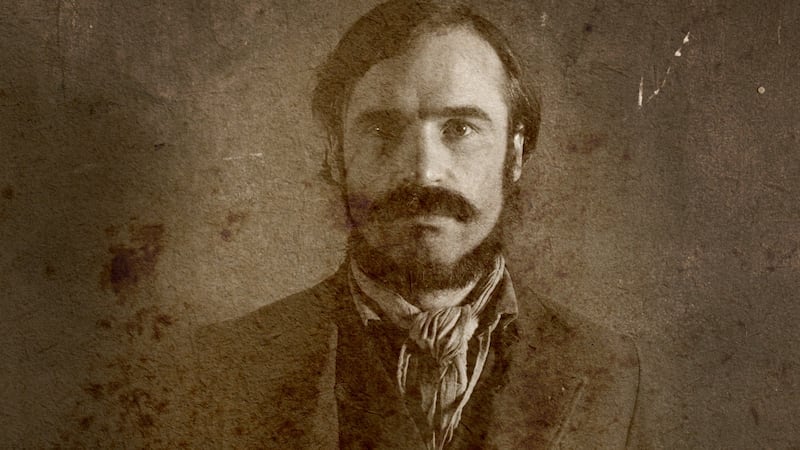Noonday sunshine beaming down on his shoulders, a man stands erect as he realises he might glimpse that light for the last time. Pinioned knees and a bag placed over his head does not quell his voice, as he exclaims in Irish that he will “see Jesus Christ in a short while . . . he too was unjustly hanged”.
It took two minutes for Myles Joyce, played by Dara Devaney, to die from strangulation, when his arm got tangled in the hangman’s rope. During the repeated reconstructions of his execution, and that of two of his neighbours, by stunt actors for a documentary filmed at Galway’s Renmore barracks last year, journalist Seán Ó Cuirreáin had to turn away.
Ó Cuirreáin, former Irish Language Commissioner, is author of an updated history of the Maamtrasna murders of August 1882, when a family of five was brutally killed in their cottage on the shores of Lough Mask on the Galway-Mayo border.
Everything that happened at the level of the State was horrendous
His book Éagóir, published two years ago, uncovered previously unreported information – including a payment of £1,250, equivalent to about €160,000 today – to several men who claimed to be eyewitnesses.
The police investigation, arrests, trial and execution of three men, and wrongful imprisonment of four others who were put under pressure to plead guilty, is still regarded as what late historian Robert Kee described as “one of most blatant miscarriages of justice in British legal history”.
Informer Tom Casey later admitted that all the men had been convicted on perjured evidence. The case prompted two members of the British House of Lords to campaign for an apology.
Posthumous pardon
Earlier this week, the Government agreed to advise President Michael D Higgins that he grant a posthumous pardon to Myles Joyce, following a review of the case by Dr Niamh Howlin of University College Dublin’s law school. In his interview for the documentary, recorded when Dr Howlin was still working on her report, Higgins noted that the “moral issue is clear”.
“Everything that happened at the level of the State was horrendous,” he said. “There was bribery involved. The accused didn’t get a proper chance to defend themselves. There wasn’t an atmosphere of equality.”
In the drama documentary made by the ROSG film company for TG4, the wider context is examined by historians and legal experts – including senior counsel Luán Ó Braonáin, Prof Gearóid Ó Tuathaigh and Dr Caitríona Clear of NUI Galway, writer Síghle Ní Chonaill, former Garda superintendent Mairtín Ó Laoi – along with descendants of those killed and those said to have been involved in the crime.
Various theories for the murders had been suggested – including a claim by the State authorities that John Joyce was treasurer of one of the local secret societies, Ribbonmen/Fenians, which opposed the landlords at that time.
“A more common theory was that John Joyce habitually stole his neighbours’ sheep from the hills,” Ó Cuirreáin says. “Others suggested that his mother Margaret was the principal target because she had allegedly informed the authorities about the location in Lough Mask where the bodies of two missing employees of a landlord had been dumped.
“Still others believed that the murders related to the overly close friendship between the daughter of the house, the teenager Peigí, and a member of the Royal Irish Constabulary,” he says.
Savage deaths
The savage deaths of the Joyce family took place just three months after the Phoenix Park murders of newly appointed chief secretary for Ireland Lord Frederick Cavendish and his permanent under-secretary, Thomas Henry Burke. The assumption that Maamtrasna must also be politically motivated explains in part the heavy-handed response, when 10 men from the surrounding area were arrested and charged.
“From Ballinrobe to Cong, to the Westminster parliament, to the Queen’s sitting room, perceptions of this incident were moulded by the understanding that the law in Ireland is dealing with barbarians,” Prof Ó Tuathaigh says. This included the jury of “well-heeled people in Dublin”, who had no Irish and who subscribed to the “barbaric” image of the west of Ireland.
Two of the three men hanged at Galway gaol – where Galway Cathedral now stands – confessed beforehand, and said Myles Joyce was totally innocent. It did not save him, nor did it save four of his neighbours, who spent 20 years in prison for a crime they did not commit.

Subsequent investigations by MP Tim Harrington led to an unfulfilled promise for a public inquiry, and contributed to the fall of William Gladstone’s government in 1885.
The documentary closes with shots of three men walking home after their eventual release in 1902, to be met by two women, including Myles Joyce’s heartbroken widow. As Ó Cuirreáin notes, the three had been put on a train from Dublin to Ballinrobe, Co Mayo, and, in the final indignity, left to make the final 18 miles home to Ceapach na Creiche “under the shadow of Maamtrasna, in the darkness and the rain”.
Earlier this week, Canadian prime minister Justin Trudeau posthumously exonerated six First Nation Tsilhqot’in chiefs who were hanged after being tricked by British colonists 154 years ago.
“So even after 136 years, it is never too late for justice,” Ó Cuirreáin says.
Murdair Mhám Trasna will be broadcast on TG4 on Wednesday, April 4th at 9.30pm












